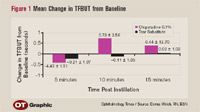Article
Olopatadine effect on TFBUT similar to tear substitute
Changes increase ocular discomfort in patients treated with systemic antihistamines.

Donna Welch, RN, BSN, and her group reported the study results at the annual meeting of the Association for Research in Vision and Ophthalmology.
Systemic antihistamines effectively treat systemic and nasal allergies, but have minimal efficacy in treating the signs and symptoms of allergic conjunctivitis in comparison with topical agents. In addition, systemic antihistamines have been reported to cause changes in tear film stability, according to Welch.
Research has shown that these changes in tear film stability after treatment with systemic antihistamines cause clinically relevant drying of the ocular surface, as measured by decreased tear-film break-up time (TFBUT) and increased corneal and conjunctival staining. In turn, these changes increase ocular discomfort in patients treated with systemic antihistamines.
A study conducted by Lauren Nally, BS, and colleagues in 2002 showed that tear flow and volume are reduced by 52% in patients taking loratadine, as measured by fluorophotometry, said Welch, chief operating officer at ORA Clinical Research and Development, North Andover, MA.
In contrast, topical antihistamines and mast cell stabilizers effectively treat the signs and symptoms of allergic conjunctivitis because they are applied directly to the affected area, according to Welch.
"To date, no published studies have reported that topical antihistamines or mast cell stabilizers are associated with ocular drying," she continued. "Olopatadine 0.1% is a combination antihistamine/mast cell stabilizer that is efficacious and comfortable in the treatment of allergic conjunctivitis. One study conducted by Murat Dogru, MD, and colleagues reported that olopatadine 0.1% actually increased TFBUT in patients with allergic conjunctivitis."
This effect of olopatadine 0.1% is possible because the drug has high H1 receptor selectivity and no muscarinic activity, and it is hypothesized that olopatadine 0.1% does not cause tear film instability. Welch and colleagues conducted this study to determine the effect of olopatadine 0.1%, compared with a widely used tear substitute, on tear film stability in subjects with normal ocular health.
Methods
Eleven subjects (55% female; mean age, 24 ± 1.2 years) with normal ocular health underwent baseline ophthalmic examinations, including TFBUT (defined as the time between opening of the eyelids and the first appearance of a growing micelle). Subjects underwent bilateral treatment with either olopatadine 0.1% or a tear substitute. The TFBUT was measured 5, 10, and 15 minutes after the drops were instilled. At least 24 hours later, subjects were crossed over to bilateral treatment with the remaining study medication. All study procedures conducted at baseline were repeated.
The mean change from baseline was calculated as the TFBUT at the 5-, 10-, or 15-minute time point minus the baseline TFBUT. The mean change from baseline was compared between the two treatment groups.
The TFBUT was measured twice per eye using 2% preservative-free sodium fluorescein and was video-recorded with an on-screen digital timer. All subjects completed the study.
Newsletter
Don’t miss out—get Ophthalmology Times updates on the latest clinical advancements and expert interviews, straight to your inbox.




